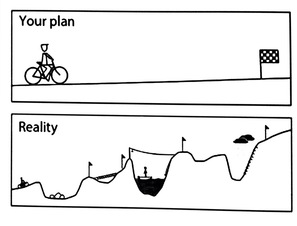 During a budget meeting in the office 2 years ago, our company's management team tackled an HR proposal for new employee additions. Our HR Head's proposal was to add 5-6 more resources for the next quarter. He presented us a list of projects along with resource requirements for each. To evaluate, we reviewed monthly resource utilization data from our internal tool. What we saw was disheartening. Hours and hours spent on non-core tasks (internal initiatives, non project-related tasks), people with allocations that were way less than regular of 7 hours per day. And yet there were people rendering overtime almost every day. Why was this so? We held another meeting, this time with Project Managers/Producers, to learn more about the problem. At the meeting, everyone agreed that we needed to hire. Everyone seemed overly stressed and tired. There was too much work. Quality was declining. And clients were feeling the pinch. In the days that followed I spoke with a few friends from other studios. I learned that they too were going through the same resource issues. It seemed like this was already the norm for everyone. Was it the industry? Was it us? It took us a while to resolve the issue, and not with lots of additional stress as well. Now two years later, I look back and analyze the problem academically. I write this post to share my insights on it. Causes What's causing scheduling problems? One cause is insufficiency in number of resources that can handle the workload. When there's very little trained people and you have work that's more than you can handle, then surely you'll have problems. Another is employee absences/tardiness. You may have enough employees, but if they're not around, then you’ll have no one to assign tasks to. Lastly, poor planning practices. This happens when prioritization is unclear, when planning is not done regularly, and when no one is accountable. I realize this last one was the most controllable of all causes.  via http://wonderingaround.me/ via http://wonderingaround.me/ How to achieve better scheduling First, determine what you really want for your firm. An ideal production pipe is one that has the right amount of employees at the right time. Load scheduling is balanced, resources are available to do work whenever they’re needed, scheduling conflicts don't exist, and employees don’t have to "cram" to death during deadlines. I call this workplace utopia. But how to achieve this, here are some steps: 1. Assign someone to oversee planning and monitoring Assign someone who can own production planning and monitoring. This could be the Head of the Project Management Office, Production Director, or Studio Manager. He/she may use as planning input the Sales Forecast. Production planning can be done on a yearly, quarterly, monthly basis. The plan can serve as guide, however it may still need to be adjusted based on priority changes as well as actual progress. In addition, it should be communicated to the team on a regular basis through email or some other means. 2. Use an automated scheduling tool to manage conflicts There are tools like Skimpl (this is our own tool. I'll talk more about it later), Toggle, and Resource Guru, which allow managers to schedule resources easily and simultaneously. This helps resolve scheduling conflicts as managers now have a way to check if a resource has already been “booked” by other managers. 3. Clear out scheduling issues during weekly meetings with PMs Make sure to address scheduling issues during weekly meetings with PMs. Encourage PMs to be more attentive to schedules and to ensure issues that exist are resolved immediately. 4. Establish efficiency statistics and monitor them. Efficiency statistics may include idleness, utilization, overtime, and timeliness in terms of project delivery. Implement rewards systems around this. This will encourage improvements and will make people more motivated. 5. Train PMs/producers on resource scheduling Organize trainings to improve PMs/producers’ knowledge in terms of resource scheduling. You can do orientations, or you can also rotate the coordination role among PMs. 6. Gather baselines in terms of estimating lead times for typical activities. This can be gathered from actual performance on past projects and collated through a document that can be discussed with PMs. This will help you create better estimates for future tasks. 7. Ensure individuals routinely manage their time Nothing beats self-discipline when it comes to time management. Make time management part of the organization's culture, and encourage everyone to self-monitor. Lastly, consult with other personnel so you can gather their inputs too. Am sure they'll have other improvement suggestions that you might wanna look at. You can also check with other firms and see if they can share best practices too. ---------- This post is an abridged version of a paper I wrote for Operations Management under Prof. Arturo Zamora. The project's requirement was to analyze a real-world problem using principles from Heizer and Render’s Operations Management book and to identify techniques that might resolve it. |
AUTHOR
I'm passionate about business, art, and technology. For more about me, click here.
BOOK PROJECT
Here's a book I co-wrote with a bunch of industry colleagues. Not sure if you'll find it useful, but feel free to check once you can. OTHER SITES
Personal
Tortured squid Hobbies & other stuff Work LegalMatch Philippines Artcebu Others Ateneo Graduate School of Business University of San Carlos Archives
October 2020
|

